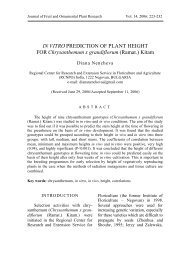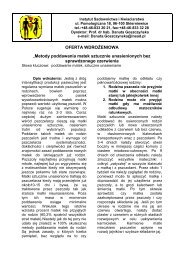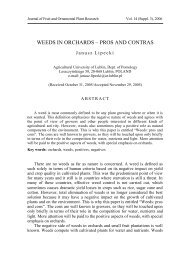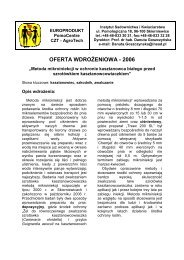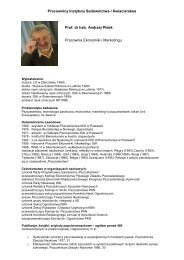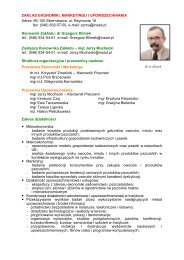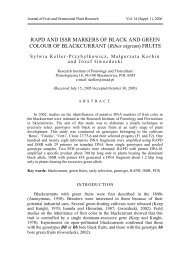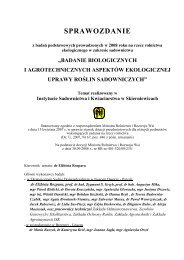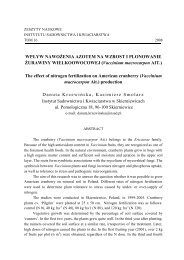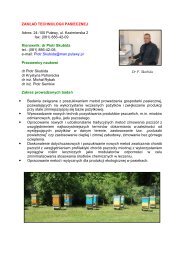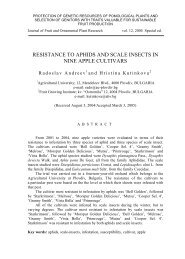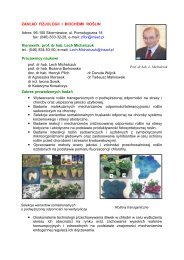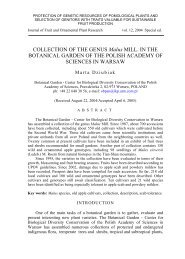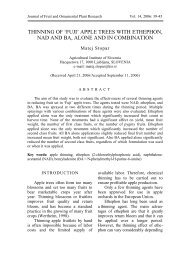and fruitlets' hand thinning of apple trees 'Å¡ampion'
and fruitlets' hand thinning of apple trees 'Å¡ampion'
and fruitlets' hand thinning of apple trees 'Å¡ampion'
You also want an ePaper? Increase the reach of your titles
YUMPU automatically turns print PDFs into web optimized ePapers that Google loves.
…fruitlets’ h<strong>and</strong> <strong>thinning</strong> <strong>of</strong> <strong>apple</strong> <strong>trees</strong> ‘Šampion’….<br />
the higher yielding control <strong>trees</strong> had significantly smaller fruit, with lower<br />
T a b l e 4 . Effect <strong>of</strong> timing <strong>of</strong> <strong>thinning</strong> practices on ‘Šampion’ <strong>apple</strong> <strong>trees</strong> on soluble<br />
solids content in fruit (1997-1999)<br />
Soluble solids content [%]<br />
Time <strong>of</strong> <strong>thinning</strong><br />
year<br />
1997 1998 1999<br />
T1 Pink bud stage 10.72 a* 13.03 b 12.18 b<br />
T2 End <strong>of</strong> flowering 10.70 a 12.55 a 11.97 b<br />
T3 Two weeks after full bloom 10.85 a 12.60 ab 11.09 a<br />
T4 After the June drop 10.22 a 13.13 b 11.71 ab<br />
T5<br />
Control <strong>trees</strong> without <strong>thinning</strong><br />
practices<br />
9.34 a 12.75 ab 10.93 a<br />
*For explanation see Table 2<br />
dry matter content. In 1999, Marcelis<br />
<strong>and</strong> Hauvelink found that dry matter<br />
partitioning into fruit could be<br />
explained as a function <strong>of</strong> the sink<br />
strength <strong>of</strong> a given fruit, in relation to<br />
the sink strength <strong>of</strong> other fruit. The<br />
number <strong>of</strong> fruitlets is <strong>of</strong> major<br />
importance as a stimulus for dry<br />
matter partitioning <strong>and</strong> fruit growth.<br />
In 1997 <strong>and</strong> 1998 the differences<br />
in soluble solids content between<br />
fruit from thinned <strong>trees</strong>, or that from<br />
the control <strong>trees</strong>, were not statistically<br />
significant (Tab. 4). In the<br />
first year <strong>of</strong> this study, the <strong>thinning</strong><br />
practices did slightly influence an<br />
increase in the values <strong>of</strong> the<br />
described features, in comparison to<br />
those <strong>of</strong> the control <strong>trees</strong>. In 1998,<br />
following <strong>thinning</strong> in the earliest <strong>and</strong><br />
the final terms (T1 <strong>and</strong> T4), the<br />
soluble solids content within the fruit<br />
slightly improved. Whereas in the<br />
last year <strong>of</strong> the experiment all <strong>of</strong> the<br />
<strong>thinning</strong> practices increased the<br />
soluble solids content, in comparison<br />
to that <strong>of</strong> the control <strong>trees</strong>, only in<br />
combinations T1 <strong>and</strong> T2 were the<br />
differences statistically significant.<br />
The results obtained in the last year<br />
confirm the observations <strong>of</strong> Johnson<br />
(1995). He had studied different terms<br />
<strong>of</strong> <strong>thinning</strong> flowers <strong>and</strong> fruitlets <strong>of</strong> cv.<br />
‘Cox Pippin’s Orange’, <strong>and</strong> stated<br />
that <strong>thinning</strong> in the earliest term, (5<br />
days after full bloom), significantly<br />
increased the soluble solids content,<br />
in comparison to that <strong>of</strong> the control<br />
<strong>trees</strong>. Delaying <strong>thinning</strong> practices<br />
had a weaker effect on the improvement<br />
<strong>of</strong> soluble solids content in<br />
the fruit. The higher soluble solids<br />
content, in the fruit from the early<br />
thinned <strong>trees</strong>, may be a reflection <strong>of</strong><br />
a higher accumulation <strong>of</strong> photosynthates.<br />
In the first year <strong>of</strong> the study only<br />
the fruit from <strong>trees</strong> thinned after the<br />
June drop (T4), had significantly<br />
lower sugar content than the fruit<br />
from all the other treatments. All<br />
other differences were not statistically<br />
significant (Tab. 5). There were<br />
no significant differences between<br />
treatments in the following year<br />
(1998). In the last year <strong>of</strong> the<br />
J. Fruit Ornam. Plant Res. vol. 14, 2006: 59-66 63



